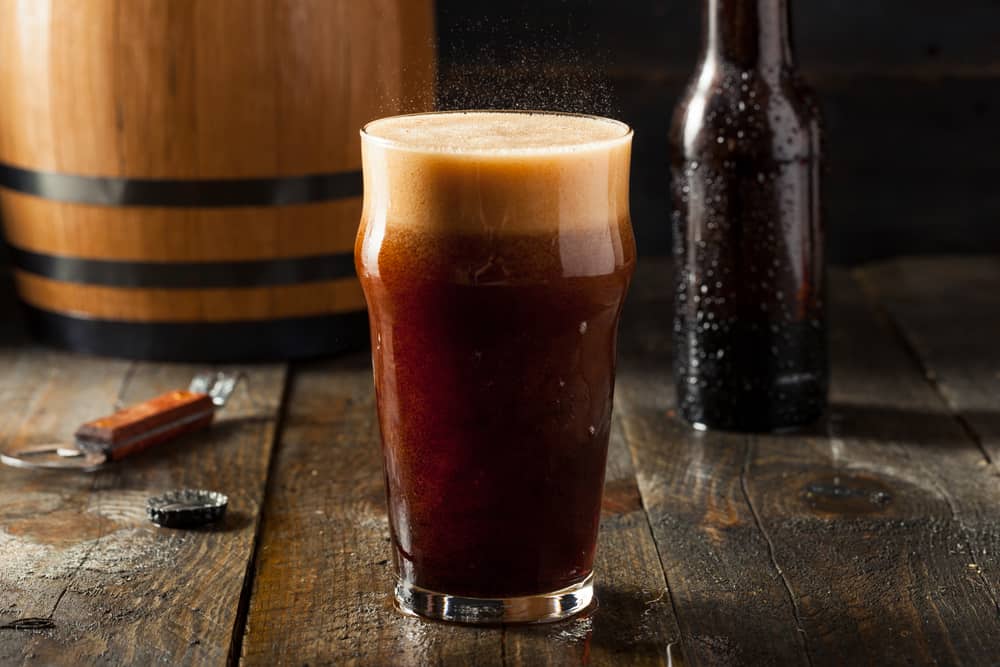Authentic root beer tastes so much better than the stuff you buy in stores and find in plastic bottles and cans. Commercial root beer often contains high fructose corn syrup, artificial flavors, and other not-so-great ingredients. Homemade root beer has a similar taste, but the flavors are richer, deeper, and even more delicious.
What’s more, authentic root beer is better for you. It’s full of probiotics and herbal root beer goodness that helps your digestion and gives the drink its signature effervescence. Once you start making root beer at home, you’ll fall in love with this drink.
If it sounds complicated, don’t worry! Making authentic root beer is a surprisingly simple process. Even better—when you make root beer at home, you control the ingredients and adjust flavors to make it exactly the way you want!

What Flavor is Root Beer?
Have you ever thought about root beer’s flavor? What flavor is root beer anyway? It’s got herbal notes, sweetness, and hints of licorice. Perhaps you’ve noticed a minty flavor in root beer? What is that?
In most natural root beers these days, the minty flavor comes from wintergreen (well, in most commercial root beers, the flavor comes from root beer extract or artificial flavoring). However, in authentic root beer, the flavor comes from sassafras.
The ingredients often used in root beer include:
- Sassafras
- Sarsaparilla
- Licorice Root
- Star Anise
- Dandelion Root
- Ginger
- Birchbark
- Wintergreen
- Sugar or Sweetener
The quantities and ingredients may vary slightly from above, depending on the recipe and personal preferences. Some people like to add more herbs or spices to their own root beer recipe, like cinnamon and cardamom. Wintergreen is often used in place of the sassafras because they both have similar minty, herbal notes. Again, you can play around with the formula to get a final product that suits your taste.
Some homemade root beers call for root beer extract or root beer concentrate, food-grade dry ice, and other ingredients, but this authentic root beer recipe is made the old-fashioned way—by brewing natural ingredients.
The History of Root Beer: An Old Brew
So, where did root beer come from? How was root beer invented? Is it literally beer made from roots?
Root beer has been around for centuries in several forms. In medieval Europe, “small beer” was a standard beverage brewed from roots, herbs, and bark. Small beer was slightly fermented but with a very low alcohol content, making it a suitable “health” drink for nearly any meal, including breakfast.
In colonial America, settlers used herbs and roots to brew small beers and teas. Many settlers used herbal remedies to cure various ailments, including in the form of beverages like teas, elixirs, and beers. The story of the first authentic root beer is that a pharmacist named Charles Hires accidentally stumbled on root beer as a cure-all “root tea.”
Early root beers were marketed as a tea that could be steeped in water and a cordial—a concentrated syrup that could be added to water. Eventually, the name was changed from root tea to root beer to make it more marketable, although it contained only trace amounts of alcohol (as do most sodas).
The health drink was especially popular during temperance as an alternative to beer and alcoholic brewed beverages. People believed that root beer had many health properties thanks to some of the herbal ingredients, including ginger, star anise, and sassafras.
Later, researchers discovered that sassafras oil or safrole may contain some carcinogens in large quantities, so artificial flavorings and wintergreen herbs were used to recreate the distinctive root beer flavor. However, rest assured that in small amounts, sassafras is largely safe for consumption, so using a tiny amount to flavor your authentic root beer shouldn’t cause any concerns. There are also safrole-free sassafras extracts available.
There are root beer extracts and flavorings on the market. You can buy root beer concentrate and add it to a soda maker to create a sugary-sweet drink. But today, we wanted to focus on the more traditional, healthy, authentic root beer. Once you learn how to make root beer, you’ll be surprised at how easy it is to brew your own at home.
The Probiotic Benefits of Root Beer
Authentic root beer includes a ginger bug, a slightly fermented form of ginger. When the ginger bug combines with the other ingredients, it adds natural bubbles thanks to the sugar and yeast. It’s similar to kombucha and other probiotic-rich fermented drinks.
If you’re looking for ways to get more probiotics in your diet, fermented beverages are a great way. I also recommend taking a probiotic supplement, such as Melaleuca’s Florify Daily Probiotic. It can be hard to get enough probiotic-rich foods in your diet throughout the day, so a supplement can help.
Authentic root beer contains probiotics and other healthy ingredients. Many herbs and spices used in root beer also have beneficial properties. For example, sassafras was thought to be a blood purifier. Despite the studies on safrole in large quantities, small amounts may even protect the liver and other organs. Dandelion and sarsaparilla are diuretics that can help flush toxins from the body. The bitter flavors of dandelion are also good for liver health. Ginger is used in many health applications, including a digestive aid (and it’s used in many other drinks, like fire cider). Licorice or anise adds a natural sweetness, which can help lower the need for additional sweeteners in the brew.
Adding a Ginger Bug to Root Beer
A ginger bug sounds like a curious ingredient. Does it contain bugs? No (other than the probiotics and natural bacteria that occur during fermentation).
Ginger has many well-known benefits. It is the flavorful base for many cuisines—Indian, Chinese, Japanese, and more; it’s also a very healthy ingredient. Herbalists have used ginger to ease nausea, aid digestion, and even regulate blood sugar. It’s helpful for headaches, bloating, cramps, and morning sickness during pregnancy.
To make a ginger bug and get the benefits of ginger, you need ginger, sugar or honey, and water. The microorganisms feed on the sugar in the mixer and release carbon dioxide, which creates the bubbly, effervescent soft drink. It’s similar to a sourdough starter in that it takes about a week to ferment. You need to cultivate and care for it during that time, but once it’s ready, you can use it for all kinds of different beverages, tonics, brews, and sodas.
A ginger bug is a wild-fermented starter culture, but it’s a little different from the starter used for ginger beer or kombucha. Ginger beer and kombucha start with a SCOBY or “symbiotic culture of bacteria and yeast.” To create a SCOBY, you need to take from an existing SCOBY, whereas a ginger bug will occur naturally with no SCOBY required.
You can use your ginger bug in many different beverages. For example, it makes a wonderful probiotic lemonade and can be a fun way to add fizz to iced tea. Try experimenting with different types of tea and different juices to get slightly different flavors in your ginger bug.
Brewing Homemade Root Beer
To make your homemade root beer recipe, you’ll start by making the ginger bug from grated or diced organic ginger (you could also swap in turmeric for a different flavor). Next, add unrefined or brown sugar or sweeteners like honey or maple syrup. Even if you’re cutting back on sugar, it’s essential to use a sweetener in your authentic root beer and your ginger bug because the sugar will feed the yeast and aid in the fermentation. Filtered or spring water works best.
Add your ginger bug ingredients to a jar, and seal it tightly. A mason jar or similar airtight container works well. Unlike some other fermented brews, you don’t need to leave the container open for the ginger bug to do its job. The bug will take between 5 and 7 days to ferment. To keep the fermentation going, you’ll need to add a small amount of fresh ginger and sugar on day four.
The ginger bug is ready for your own homemade root beer when it gets foamy and has a clean, yeasty smell (similar to bread). You can continue to feed and store it in the fridge for a week or use it for your root beer right away.
When you’re ready to make your root beer, you’ll simmer herbs until they become fragrant and the mixture has steeped. Next, you’ll add sweetener and your freshly made ginger bug to the brew and then pour it into bottles so it can ferment.
During the fermentation process, homemade root beer will start to get fizzy. It will build natural probiotics and become a delicious, healthy elixir that’s a great alternative to any corn syrup-sweetened soda you’d buy in the store. This root beer is all-natural and full of good ingredients.
Delicious homemade root beer is a delightful drink full of health benefits. It’s a fantastic way to enjoy the many benefits of natural herbs and roots. Once you try authentic root beer, you’ll never return to that syrupy store-bought stuff again!
Authentic Root Beer Recipe
Ingredients:
- 10 cups of cold water
- 3 tablespoons of dried sarsaparilla root
- 1 tablespoon of dried licorice root
- 1 tablespoon of freshly grated ginger
- 2 teaspoons birch bark
- ¼ cup sassafras root bark
- ¾ cup sugar or equivalent sweetener
- ½ cup ginger bug
Optional:
- 1-2 teaspoons dried dandelion root
- 1 star anise pod
- 1 sprig of wintergreen
Directions:
Pour the 10 cups of cold water into a pot, and add the herbal ingredients—sarsaparilla, licorice, ginger, birch bark, dandelion root, and star anise. Bring the mixture to a boil over high heat and then reduce it to a simmer for 30 minutes.
Add the sassafras root bark and simmer for 10-15 minutes longer. Remove the mixture from heat and add the sweetener or sugar. Stir until it is completely dissolved. Cool the mixture at room temperature.
After two hours, strain the mixture and add the ginger bug. Keep in mind that adding the ginger bug to a hot mixture will kill the culture.
Pour your authentic homemade root beer into bottles with about two inches of room at the top to allow for fermentation. Flip-top plastic or glass bottles are ideal for homemade root beer. To ferment, the root beer should rest for 2-3 days at room temperature. Then refrigerate for an additional 3-4 days.
Once your root beer is fully brewed, enjoy it over ice for a nourishing healthy treat. Garnish with a sprig of wintergreen.
For other herbal beverage ideas, don’t miss:








Comments & Reviews
How much does it make?
Hello Christian,
Thanks for your question. I believe this recipe makes about 5-10 cups of root beer.
I hope that helps you in brewing this!
Charlene
Do you have any suggestions or favorite websites for where to source the ingredients for this recipe?
Certainly Hannah,
Yes, I can suggest some websites to source ingredients for this recipe. My best suggestion is Mountain Rose Herbs – https://mountainroseherbs.com/
They provide high quality organic herbs that can be used for a lot of culinary creations.
Hope that helps!
Charlene
Ok I just poured into gt kombucha bottles, do I need to check carbonation during counter time or refrigeration time. Any chance will explode?
Hello Kristy,
Thanks for asking. I am glad you were able to brew this! Regarding carbonation checking and refrigeration, my best recommendation is to refrigerate right away to keep it fresh. In this way, the beverage should last around 6 months to a year. If you keep it refrigerated, it should not pop or explode, and it should be pretty stable that whole time. Obviously, I don’t recommend shaking it 🙂
Cheers and enjoy,
Charlene
Will the Fermentation cause alcohol to form?
Hello John,
Good question! The best answers would be, yes, but only to the degree that it forms in fermented teas such as kombucha. So, it would be a very negligible amount of alcohol formation.
Hope that helps your efforts in brewing this.
~Charlene
Will the fermentation cause significant amounts of alcohol to form?